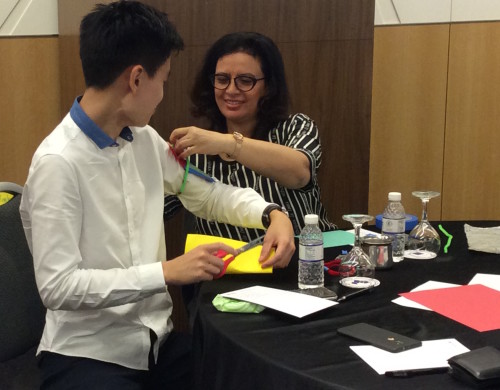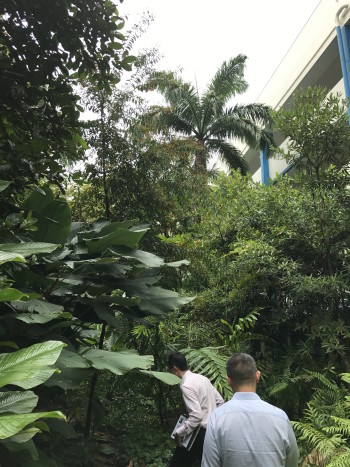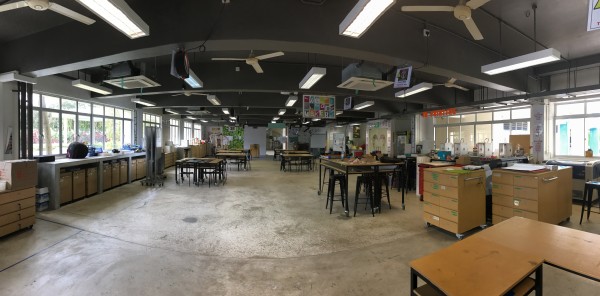In the middle of March 2017, Daniella Shoshan and Stephanie Chang criss-crossed the globe to run professional development workshops in Singapore. Here, they reflect on their experiences.
For all of the differences that come with a culture and country halfway around the world, the similarities are actually what are most striking. In partnership with the Singapore’s Ministry of Education, the Principals Academy, and Commonwealth Secondary School Center of Excellence in Design and Innovation, we had the privilege to spend 5 days in Singapore, running workshops on maker education and open portfolios, as well as meeting and discussing the nuances of what a hands-on, open-ended, and student-driven approach can look like and can do.
 In day-long workshops, we worked closely with a total of over 150 educators during the week. Some were raving fans of maker education, committed to facilitating a mindset shift and engagement with all students, and others were just getting started in learning how and why maker education is an important approach to consider.
In day-long workshops, we worked closely with a total of over 150 educators during the week. Some were raving fans of maker education, committed to facilitating a mindset shift and engagement with all students, and others were just getting started in learning how and why maker education is an important approach to consider.
Classroom teachers, representatives from the Ministry’s Innovation groups, principals of primary and secondary schools, and community makerspace educators all joined us to participate as both learners and facilitators. The creativity that appeared on mornings of their midterm break were glorious, and like educators whom we’ve worked with in the U.S., they doubled over in both laughter and frustration at their own inventions and ideas.
 For both types of workshops, participants spent their mornings in collaborative, hands-on challenges, followed by periods of reflection and debrief. Most afternoons were filled with deep, intense conversation around what their schools and classrooms could do to best integrate maker-centered learning, documentation and portfolios, and a generally more student-centered focus.
For both types of workshops, participants spent their mornings in collaborative, hands-on challenges, followed by periods of reflection and debrief. Most afternoons were filled with deep, intense conversation around what their schools and classrooms could do to best integrate maker-centered learning, documentation and portfolios, and a generally more student-centered focus.
The educators were sometimes a bit quieter than ones we’ve partnered with in other workshops. Their burning questions came through in small-group discussions, evolving throughout the days. There were common curiosities though: questions about safety, about facilitation approach and the comfort of teacher not-knowing all the answers, about best materials and activities to start with, about time & energy expended.

Singapore is quite a different country and culture from the United States, naturally drawing on history, influences, and expectations of SE Asia. Students wear uniforms, seem less boisterous (though we laughed that students are students), and stay put in classrooms while teachers rotate, but Singapore is also an epicenter of innovation, business, and modern technology. A young country with a beautiful meld of influences, it seems to embrace a balance of modernity and urban growth with the richness of its food and environment.
In our visit to Commonwealth Secondary School’s campus the following week, it was incredible to see the growth of a versatile library space, a huge makerspace that encompasses traditional woodworking with crafts and 3D design, a design loft for educator collaboration, a wetlands for scientific discovery, and a true mid-campus jungle that organically (ha!) invites wildlife to high school biology conversations. Across the country (about 20 minutes away) is also a community makerspace (Makedemy) and lab (Sustainable Living Labs) co-located on a World College campus. They engage expats and locals alike in out-of-school-time opportunities to learn and make.

As reassuring and refreshing as it was to discover familiarity 8,000 miles across the globe, we were also surprised by what surprised us. We were initially quite struck by the number of male educators in attendance at the workshops, prompting us to ask ourselves when and why we had become so accustomed to seeing mostly female faces in education-focused gatherings. We were also taken aback by how plainly and profoundly education (and educators) are valued in Singapore, as though resistance and under-appreciation have become so ubiquitous at home that the notion of the opposite is confounding. The opportunity to gut-check what we take as givens in our daily “norms” and circles was yet another full plate of food for thought.
We all have lessons and wisdom to learn from one another, and the opportunities and challenges that we encounter as a global society are what will propel us forward. Singapore’s educational system is strict in a sense, but that’s what makes maker-centered learning — both there and here and really, anywhere — such an opportunity for up-ending our assumptions and expectations of students’ ability, voice, and success. It’s awesome to consider the simultaneous experiences we’re creating for our youth from opposite ends of the world.
